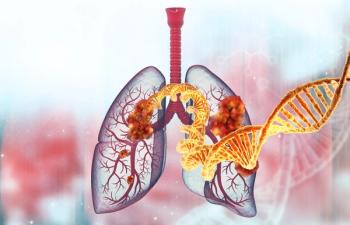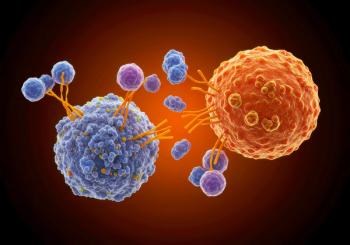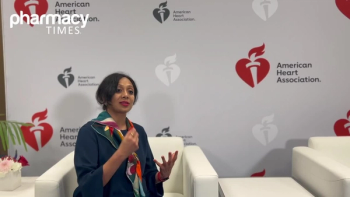
Treosulfan Improves Survival and Lowers Mortality Prior to Allo-HSCT in Patients With Myelofibrosis
Key Takeaways
- Treosulfan conditioning improved progression-free survival and reduced non-relapse mortality compared to busulfan in myelofibrosis patients undergoing allo-HSCT.
- Myelofibrosis is a myeloproliferative neoplasm with poor outcomes, where allo-HSCT remains the only curative therapy despite high risks.
Treosulfan showed superior benefits to busulfan as a conditioning regimen before allogenic hematopoietic stem cell transplantation (allo-HSCT).
Treosulfan (Trecondi; medac GmbH) conditioning (TREO) demonstrated improved progression-free survival (PFS) and non-relapse mortality (NRM) compared with busulfan (Myleran; Otsuka America Pharmaceutical Inc) conditioning (BU) prior to allogenic hematopoietic stem cell transplantation (allo-HSCT) in patients with myelofibrosis (MF), according to data published in Bone Marrow Transplantation.1
MF is an uncommon clonal stem-cell process that causes increasingly reduced red blood cell production, resulting in bone marrow fibrosis, extramedullary hematopoiesis, frequent splenomegaly, and anemia. It is a type of myeloproliferative neoplasm with a tendency toward leukemic progression and typically poor outcomes. Use of emerging therapies such as Janus kinase inhibitors have increased in response to promising results observed in clinical trials, showing both improved symptoms and survival.1
However, allo-HSCT remains the only curative therapy capable of modifying MF despite being associated with high risks of treatment-related morbidity and mortality as well as relapse. Conditioning regimens are an essential component of allo-HSCT to provide sufficient immunoablation to prevent graft rejection and reduce the tumor burden. Treosulfan and busulfan are both chemotherapy agents used in conditioning regimens prior to allo-HSCT that have demonstrated meaningful improvements in outcomes of stem cell therapies.2-5
In the registry-based study, the researchers compared outcomes following TREO or BU conditioning in 530 patients with MF, of which 73 received TREO and 457 received BU. The patients were divided into 3 cohorts: the TREO arm, the BU-high dose (BU-HD) arm, and the BU-RIC arm. They used adjusted Cox models to compare outcomes of the treatments in each group.1
According to the data, the TREO cohort demonstrated significantly better overall survival than BU-HD (HR:0.61, 95% CI: 0.39–0.93) and a trend towards better OS over BU-RIC (HR: 0.66, 95% CI: 0.41–1.05). Additionally, TREO showed superior capabilities in PFS than BU-HD (HR: 0.57, 95% CI: 0.38–0.84) and BU-RIC (HR: 0.60, 95% CI: 0.39–0.91) cohorts. NRM was reduced in both the TREO and BU-RIC cohorts (HR: 0.44, 95% CI: 0.24–0.80 TREO vs BU-HD; HR: 0.54, 95% CI: 0.28–1.04 TREO vs BU-RIC). The researchers reported that risk of relapse, as well as instances of engraftment and acute graft-versus-host-disease (GHVD), were similar across the cohorts.1
These data emphasize TREO’s potential to offer a more effective and less toxic alternative, especially in reducing treatment-related mortality while maintaining similar rates of relapse and GVHD. Continued studies are needed to further confirm these findings and provide a deeper understanding of the risks and benefits of these conditioning agents for patients with MF.
REFERENCES
1. Robin M, Iacobelli S, Koster L, et al. Treosulfan compared to busulfan in allogeneic haematopoietic stem cell transplantation for myelofibrosis: a registry-based study from the Chronic Malignancies Working Party of the EBMT. Bone Marrow Transplant. March 15, 2024. doi:10.1038/s41409-024-02269-4
2. Gyurkocza B, Sandmaier BM. Conditioning regimens for hematopoietic cell transplantation: one size does not fit all. Blood. June 9, 2014. doi:10.1182/blood-2014-02-514778
3. Tiribelli M, Palandri F, Sant-Antonio E, et al. The role of allogeneic stem-cell transplant in myelofibrosis in the era of JAK inhibitors: a case-based review. Bone Marrow Transplantation. September 18, 2019. doi: 10.1038/s41409-019-0683-1
4. Treosulfan. Cancer Research UK. May 4, 2022. Accessed October 7, 2024. https://www.cancerresearchuk.org/about-cancer/treatment/drugs/treosulfan
5. Busulfan. Cancer Research UK. September 5, 2024. Accessed October 7, 2024. https://www.cancerresearchuk.org/about-cancer/treatment/drugs/busulfan#:~:text=Busulfan%20is%20a%20type%20of,myeloproliferative%20neoplasms%20or%20myeloproliferative%20disorders
Newsletter
Stay informed on drug updates, treatment guidelines, and pharmacy practice trends—subscribe to Pharmacy Times for weekly clinical insights.















































































































































































































